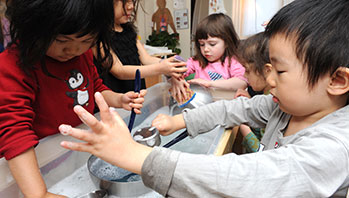- knife (for teacher)
- paper plates
- small slices of peeled apple
- small slices of peeled potato (same shape as apple slices)
- variety of bite-sized plant foods that have different tastes and textures (orange, banana, celery, radish, green peppers, carrots, parsley, onion, etc.)
- aroma
- entice
- sense
MA Standards:
Language/L.PK.MA.6: Use words and phrases acquired through conversations, listening to books read aloud, activities, and play.
MA Draft Standards:
Life Sciences/From Molecules to Organisms: Inheritance and Variation of Traits/LS1/3.C: Use their sense in their exploration and play to gather information. [Structure and Function]
Head Start Outcomes:
Logic and Reasoning/Reasoning and Problem Solving: Classifies, compares, and contrasts objects, events, and experiences.
Science Knowledge/Scientific Skills and Method: Observes and discusses common properties, differences, and comparisons among objects.
PreK Learning Guidelines:
English Language Arts/Language 2: Participate actively in discussions, listen to the ideas of others, and ask and answer relevant questions.
Science and Technology/Living Things and Their Environment 15: Use their senses of sight, hearing, touch, smell, and taste to explore their environment using sensory vocabulary.
Explore Together (indoors): Taste and Compare

© Commonwealth of Massachusetts, Department of Early Education and Care (Jennifer Waddell photographer). All rights reserved.
STEM Key Concepts: There are many different types of plants; Many foods that animals, including humans, eat come from plants; We eat certain leaves, roots, fruits, and seeds
ELA Focus Skills: Compare and Contrast, Listening and Speaking, Vocabulary
Educator Prep: Prepare plates of food for pairs of children to explore and compare. Use small bite-sized pieces of available plant foods.
Safety Tips:
- Remind children to wash their hands before and after the activity.
- Children’s food allergies need to be taken into account before allowing children to eat any foods.
Tell children they are going to compare plant foods. Explain that you want children to taste, smell, feel, and look at the foods so they can compare them. Before children begin, demonstrate with two fruits that look similar, such as a slice of a peeled apple and a slice of a peeled potato. Tell children that you are going to give them two foods to explore.
- Place a paper plate with a slice of an apple and a slice of potato in front of each child. Before they begin to explore the slices ask, Do you think these are the same food? Why do you think that?
- Then have children explore the smell, feel, texture, and taste of each slice. Have them compare and describe the two slices of food. Encourage the use of descriptive words.
Ask questions such as,
- What did you notice that was different about the taste of each food?
- What was similar about the two foods?
- Do you know what part of the plant each type of food came from?
Have children work in pairs to explore the plant foods. Guide them to try the pairs of food together and describe what is the same and different about each one. Encourage them to think about what part of the plant each food is from. Take pictures or videos as children explore the foods. Circulate and answer questions or engage when children are excited about something they observed. Ask questions such as,
- What was it about the radish that surprised you? How did it taste?
- What did you notice about the smell of the onion? Did it smell the same as the onion plant you are growing?
- What about the <parsley> makes you think it is the leaf of the plant?
Reflect and Share
Discuss the activity. Ask questions such as,
- What food taste surprised you the most? Why was that? Did it taste like any of the other foods you tried?
- Were there any foods you did not taste because you did not like the smell or the feel of it? Can you describe the smell or feel?
- Can you tell me one food that you tasted that was the root of the plant? Leaf? Fruit?
- What was different about the texture of the banana and the texture of the orange?
- How was the sound different when you ate the celery and when you ate the banana?
Take It Further: Place a vegetable or a fruit in a number of paper bags. Give a child one of the bags. Ask him or her to, without looking, use his or her other senses to describe the object inside. Have the rest of the group guess what is being described. Let children take turns with the rest of the bags.
Adaptation: Adapt the materials and procedures if younger children will be working in a group. You might prefer to have each young child do the activity individually, with one-to-one supervision.
